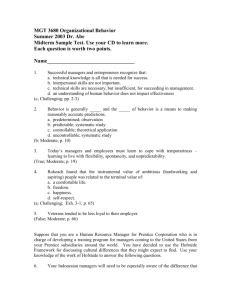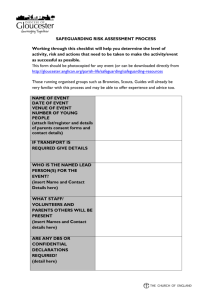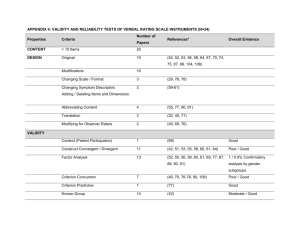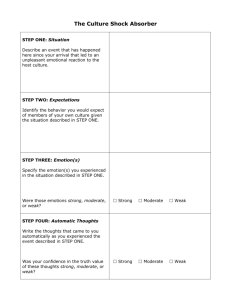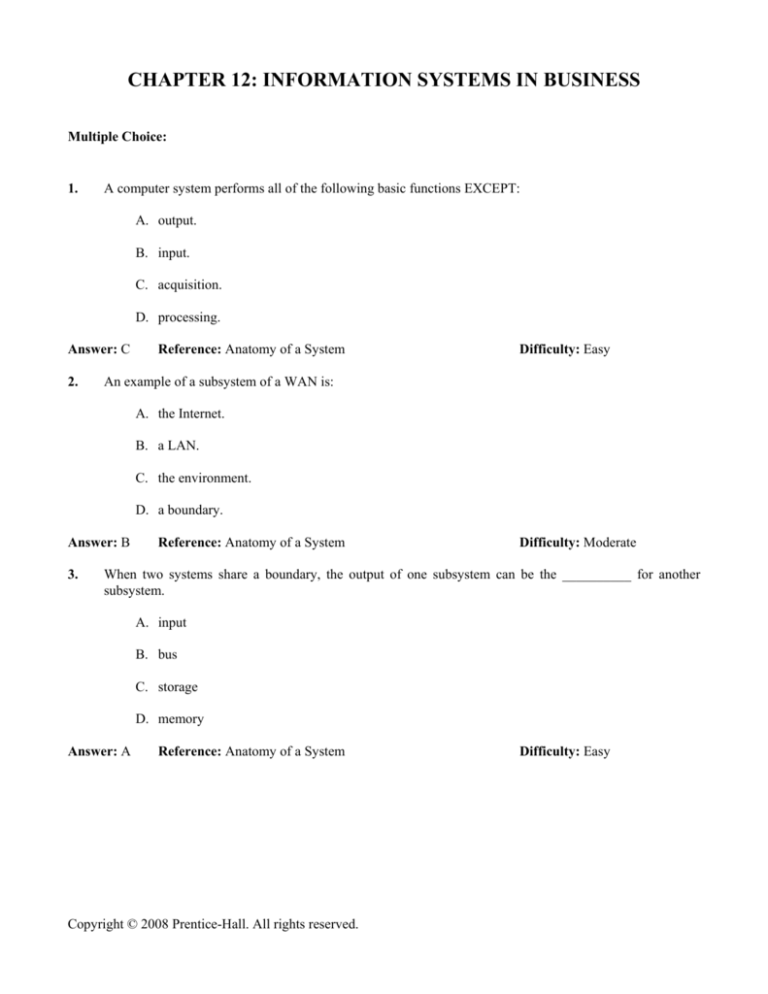
CHAPTER 12: INFORMATION SYSTEMS IN BUSINESS
Multiple Choice:
1.
A computer system performs all of the following basic functions EXCEPT:
A. output.
B. input.
C. acquisition.
D. processing.
Answer: C
2.
Reference: Anatomy of a System
Difficulty: Easy
An example of a subsystem of a WAN is:
A. the Internet.
B. a LAN.
C. the environment.
D. a boundary.
Answer: B
3.
Reference: Anatomy of a System
Difficulty: Moderate
When two systems share a boundary, the output of one subsystem can be the __________ for another
subsystem.
A. input
B. bus
C. storage
D. memory
Answer: A
Reference: Anatomy of a System
Copyright © 2008 Prentice-Hall. All rights reserved.
Difficulty: Easy
Chapter 12: Information Systems in Business
4.
When the output of one subsystem is used as input for another subsystem, the two systems have a shared:
A. memory.
B. boundary.
C. EDI.
D. critical path.
Answer: B
5.
Reference: Anatomy of a System
Difficulty: Moderate
A store’s environment includes all of the following EXCEPT:
A. customers.
B. suppliers.
C. managers.
D. competitors.
Answer: C
6.
Reference: Business Organizations as Systems
Difficulty: Moderate
__________ activities support a company’s primary activities.
A. Outsourced
B. Efficiency
C. Core
D. Secondary
Answer: D
7.
Reference: The Value Chain Model
Difficulty: Moderate
A value chain’s primary activities include all of the following EXCEPT:
A. marketing and sales.
B. human resources.
C. operations.
D. service.
Answer: B
Reference: The Value Chain Model
Copyright © 2008 Prentice-Hall. All rights reserved.
Difficulty: Moderate
2
Chapter 12: Information Systems in Business
8.
In the value chain model, the primary activity ____________ includes receiving, storing, and distributing
raw materials.
A. marketing and sales
B. operations
C. service
D. inbound logistics
Answer: D
9.
Reference: The Value Chain Model
Difficulty: Moderate
In the value chain model, the primary activity which refers to delivering the products or services to
customers is:
A. marketing and sales.
B. outbound logistics.
C. service.
D. inbound logistics.
Answer: B
10.
Reference: The Value Chain Model
Difficulty: Moderate
In the value chain model, the primary activity, ____________ is the process of creating products or
services from raw materials.
A. marketing and sales
B. operations
C. service
D. inbound logistics
Answer: B
11.
Reference: The Value Chain Model
Difficulty: Moderate
In the value chain model, the primary activity, ____________ is concerned with finding customers and
getting orders from them.
A. marketing and sales
B. operations
C. service
D. inbound logistics
Answer: A
Reference: The Value Chain Model
Copyright © 2008 Prentice-Hall. All rights reserved.
Difficulty: Easy
3
Chapter 12: Information Systems in Business
12.
In the value chain model, secondary activities include all of the following EXCEPT:
A. procurement.
B. management and administrative services.
C. marketing.
D. technology development.
Answer: C
13.
Reference: The Value Chain Model
Difficulty: Moderate
A company’s environment includes all of the following EXCEPT:
A. competitors.
B. employees.
C. customers.
D. stockholders.
Answer: B
14.
Reference: Information Systems
Difficulty: Easy
A ____________ is an example of input for an information system.
A. financial statement
B. screen display
C. paycheck
D. sales transaction
Answer: D
15.
Reference: Information Systems
Difficulty: Easy
A(n) ____________ is an example of output from an information system.
A. printer
B. employee paycheck
C. customer address change
D. scanner
Answer: B
Reference: Information Systems
Copyright © 2008 Prentice-Hall. All rights reserved.
Difficulty: Easy
4
Chapter 12: Information Systems in Business
16.
A(n) ____________ is a subsystem supporting the information needs of other business processes within the
organization.
A. information system
B. infrastructure
C. technology management system
D. operating system
Answer: A
17.
Reference: Information Systems
Difficulty: Moderate
All of the following are examples of transactions in an information system EXCEPT:
A. manufacture widget.
B. sell item.
C. hire new employee.
D. enhance memory capacity.
Answer: D
18.
Reference: Information Systems for Business Transactions
Difficulty: Moderate
A(n) ____________ is a record-keeping system that keeps track of accounting transactions on a daily basis.
A. IOS
B. executive information system
C. transaction processing system
D. expert system
Answer: C
19.
Reference: Information Systems for Business Transactions
Difficulty: Moderate
The first step in the transaction processing cycle is:
A. database operations.
B. audit.
C. data entry.
D. user inquiry.
Answer: C
Reference: Information Systems for Business Transactions
Copyright © 2008 Prentice-Hall. All rights reserved.
5
Difficulty: Moderate
Chapter 12: Information Systems in Business
20.
All of the following are examples of transaction processing systems EXCEPT:
A. accounts receivable.
B. payroll.
C. group decision support system.
D. general ledger.
Answer: C
21.
Reference: Information Systems for Business Transactions
Difficulty: Easy
For a TPS, all of the following are action documents EXCEPT
A. bills.
B. receipts.
C. credit cards.
D. packing lists.
Answer: C
22.
Reference: Information Systems for Business Transactions
Difficulty: Easy
EDI stands for:
A. electronic data interchange.
B. electrical data interchange.
C. electronic data on the Internet.
D. enhanced data interchange.
Answer: A
23.
Reference: Information Systems for Business Transactions
Difficulty: Moderate
____________ processing gathers data and processes it later.
A. Real-time
B. Late entry data
C. Batch
D. Entry specific
Answer: C
Reference: Information Systems for Business Transactions
Copyright © 2008 Prentice-Hall. All rights reserved.
6
Difficulty: Moderate
Chapter 12: Information Systems in Business
24.
A library information system using a database to revise information about inventory levels after a book is
checked out is an example of:
A. batch processing.
B. EDI.
C. storage and retrieval.
D. acquisition.
Answer: C
25.
Reference: Information Technology in Information Systems
Difficulty: Moderate
When a sales manager makes a chart and spreadsheet for a monthly sales report, the manager is using the
IT function called:
A. processing.
B. presentation.
C. acquisition.
D. storage and retrieval.
Answer: B
26.
Reference: Information Systems
Difficulty: Moderate
The IT function, ____________ is manipulating and organizing information for the benefit of the user.
A. presentation
B. storage and retrieval
C. processing
D. acquisition
Answer: C
27.
Reference: Information Systems
Difficulty: Moderate
When an instructor forwards student marks to another instructor, it is an example of the IT function called:
A. transmission.
B. storage and retrieval.
C. processing.
D. acquisition.
Answer: A
Reference: Information Systems
Copyright © 2008 Prentice-Hall. All rights reserved.
Difficulty: Moderate
7
Chapter 12: Information Systems in Business
28.
A sale reducing the number in stock would be recorded in a(n):
A. expert system.
B. ERP system
C. accounts payable transaction.
D. inventory control transaction.
Answer: D
Moderate
29.
Reference: The Information Flow through a Transaction Processing System
Difficulty:
A(n) ____________ transaction processing system reports business income and expenses in monthly
reports so that the financial health of the company can be determined.
A. general ledger
B. accounts payable
C. inventory control
D. payroll
Answer: A
Moderate
30.
Reference: The Information Flow through a Transaction Processing System
Difficulty:
An enterprise resource planning (ERP) system increases the:
A. quality of the data of a transaction subsystem.
B. degree of error discovery of a transaction subsystem.
C. ability to share information between business processes.
D. amount of paperwork generated by a business.
Answer: C
31.
Reference: Enterprise Resource Planning
Difficulty: Challenging
Which of the following does NOT describe the attributes of an ERP system?
A. Simplistic
B. Complex
C. Large
D. Expensive
Answer: A
Reference: Enterprise Resource Planning
Copyright © 2008 Prentice-Hall. All rights reserved.
8
Difficulty: Challenging
Chapter 12: Information Systems in Business
32.
When two different businesses agree to work together, it is known as a:
A. strategic plan.
B. business alliance.
C. value chain.
D. corporation.
Answer: B
33.
Reference: Supply Chain Management and Outsourcing
Difficulty: Moderate
An information system that supports international business activities is called a(n):
A. International information system.
B. EIS.
C. EDI.
D. Internet supplier system.
Answer: A
34.
Reference: Supply Chain Management and Outsourcing
Difficulty: Moderate
The direct, computer-to-computer exchange of standardized, common business transaction documents
between business partners, suppliers, and customers is:
A. EDI.
B. ES.
C. EIS.
D. ERP.
Answer: A
35.
Reference: Supply Chain Management and Outsourcing
Difficulty: Easy
A business alliance linking systems of several companies who are in the same industry is called a(n)
____________ network:
A. Enterprise Resource Planning
B. ES
C. Industrial
D. International Standards Organization
Answer: C
Reference: Supply Chain Management and Outsourcing
Copyright © 2008 Prentice-Hall. All rights reserved.
9
Difficulty: Moderate
Chapter 12: Information Systems in Business
36.
When a purchasing manager buys more computer paper for the office, she is making a(n) _____________
decision.
A. unstructured
B. tactical
C. structured
D. strategic
Answer: C
37.
Reference: Information Technology and Management
Difficulty: Easy
When a Chief Executive Officer decides to open up a branch office in China, the CEO is making a(n)
____________ decision.
A. structured
B. tactical
C. unstructured
D. operational
Answer: C
38.
Reference: Information Technology and Management
Difficulty: Easy
When an instructor determines the number of textbooks to order for an additional Monday night offering of
an existing computer course, the instructor is making a(n) ____________ decision:
A. unstructured
B. strategic
C. semistructured
D. tactical
Answer: C
39.
Reference: Information Technology and Management
Difficulty: Challenging
Middle managers primarily manage at the __________ level.
A. tactical
B. operational
C. top management
D. strategic
Answer: A
Reference: Information Technology and Management
Copyright © 2008 Prentice-Hall. All rights reserved.
10
Difficulty: Challenging
Chapter 12: Information Systems in Business
40.
A company’s board of directors acts at the __________ level.
A. tactical
B. operational
C. middle management
D. strategic
Answer: D
41.
Reference: Information Technology and Management
Difficulty: Moderate
The ____________ is the top manager responsible for the overall planning of information systems within a
company.
A. CEO
B. Controller
C. CIO
D. DBA
Answer: C
42.
Reference: Information Technology and Management
Difficulty: Moderate
MIS stands for:
A. management Internet system.
B. marketing Internet system.
C. marketing and implementation software.
D. management information system.
Answer: D
43.
Reference: Management Information Systems
Difficulty: Moderate
The Management Information System receives input from the:
A. EIS.
B. ES.
C. DSS.
D. TPS.
Answer: D
Reference: Management Information Systems
Copyright © 2008 Prentice-Hall. All rights reserved.
11
Difficulty: Easy
Chapter 12: Information Systems in Business
44.
The ____________ provides a manager with the information needed to make decisions regarding the firm’s
operational activities.
A. EIS
B. ES
C. MIS
D. EDI
Answer: C
45.
Reference: Management Information Systems
Difficulty: Easy
A(n) ____________ helps a manager make semistructured decisions by providing tools to help analyze
information.
A. EDI
B. DSS
C. TPS
D. ES.
Answer: B
46.
Reference: Decision Support Systems
Difficulty: Easy
If you were planning delivery routes for your business, you might find a(n) ____________ helpful.
A. GIS.
B. MIS.
C. EDI.
D. DSS.
Answer: A
47.
Reference: Decision Support Systems
Difficulty: Easy
A(n) ____________ system is designed based on the knowledge of a highly-skilled professional in a
particular field.
A. executive information
B. knowledge
C. expert
D. management information
Answer: C
Reference: Expert Systems
Copyright © 2008 Prentice-Hall. All rights reserved.
Difficulty: Moderate
12
Chapter 12: Information Systems in Business
48.
A combination of a MIS and DSS called a(n) ____________ helps top managers make decisions.
A. GIS
B. EIS
C. EDI
D. CAM
Answer: B
49.
Reference: Executive Information Systems
Difficulty: Moderate
When a company develops a new product that competitors have difficulty imitating, that company has
created a(n):
A. competitive advantage.
B. switching cost mechanism.
C. entry barrier.
D. high efficiency quota.
Answer: C
50.
Reference: Strategic Information Systems
Difficulty: Moderate
Too many reports! Too many printouts! This is known as a(n):
A. run-time error.
B. data log.
C. information overload.
D. decision support system.
Answer: C
51.
Reference: Information Systems in Perspective
Difficulty: Easy
The first phase of IT planning is called ____________ planning.
A. tactical
B. project
C. organizational
D. strategic
Answer: D
Reference: Strategic Planning
Copyright © 2008 Prentice-Hall. All rights reserved.
Difficulty: Moderate
13
Chapter 12: Information Systems in Business
52.
To analyze their information requirements, many companies use ____________ to define their IT
infrastructure:
A. enterprise modeling
B. spreadsheet modeling
C. optimization analysis
D. project planning
Answer: A
53.
Reference: Describing the Information Technology Infrastructure
Difficulty: Moderate
A manager could use ____________ to determine if an information system project is economically
worthwhile.
A. Gantt charts
B. program evaluation and review technique (PERT) charts
C. cost-benefit analysis
D. expert systems
Answer: C
54.
Reference: Allocating Resources
Difficulty: Moderate
The third phase of information technology planning is ____________, in which information system
projects are selected.
A. IT infrastructure description
B. resource allocation
C. project planning
D. strategic planning.
Answer: B
55.
Reference: Allocating Resources
Difficulty: Easy
The fourth phase of IT planning is ____________ planning.
A. hardware
B. network
C. project
D. strategic
Answer: C
Reference: Project Planning
Copyright © 2008 Prentice-Hall. All rights reserved.
Difficulty: Easy
14
Chapter 12: Information Systems in Business
56.
Managers use all of the following to identify problems in a project EXCEPT:
A. Gantt chart.
B. PERT diagram.
C. CPM.
D. CSF.
Answer: D
57.
Reference: Project Planning
Difficulty: Moderate
In a(n) ____________ diagram, a manager uses three time estimates: an optimistic, a pessimistic, and a
most likely time for completion of each activity.
A. CPM
B. PERT
C. CSF
D. Gantt
Answer: B
58.
Reference: Project Planning
Difficulty: Moderate
Social responsibility applies to:
A. both individuals and companies.
B. only companies.
C. only the community.
D. only the government.
Answer: A
59.
Reference: Social Responsibility in the Information Age
Difficulty: Easy
The ethical guideline, ____________ states that a person should take the action that achieves the greatest
good for all involved.
A. code of ethics
B. informed consent
C. most restrictive action
D. higher ethic
Answer: D
Reference: Social Responsibility in the Information Age
Copyright © 2008 Prentice-Hall. All rights reserved.
15
Difficulty: Easy
Chapter 12: Information Systems in Business
60.
“If in doubt, get permission before proceeding” is an example of which ethical guideline?
A. Code of ethics.
B. Informed consent.
C. Most restrictive action.
D. Higher ethic.
Answer: B
61.
Reference: Social Responsibility in the Information Age
Difficulty: Easy
“When deciding on an action, assume its most severe consequence and act accordingly.” This is the ethical
guideline:
A. code of ethics
B. informed consent
C. most restrictive action
D. higher ethic
Answer: C
62.
Reference: Social Responsibility in the Information Age
Difficulty: Easy
Concerning business intelligence, all of the following are true EXCEPT:
A. data is collected, manipulated, and analyzed for better decision making.
B. it may be provided through use of a digital dashboard.
C. managers cannot access the system themselves.
D. it may predict the impact of a decision.
Answer: C
Reference: Organizational Efficiencies through Business Intelligence
Difficulty: Moderate
Fill in the Blank:
63.
A system performs three basic functions: input, ____________, and output.
Answer: processing
64.
Reference: Anatomy of a System
Difficulty: Easy
In addition to the three basic functions, a system has two additional functions: ____________ and control.
Answer: feedback
Reference: Anatomy of a System
Copyright © 2008 Prentice-Hall. All rights reserved.
16
Difficulty: Challenging
Chapter 12: Information Systems in Business
65.
The ____________ function evaluates feedback data and adjusts the system’s input and processing
functions accordingly.
Answer: control
66.
Difficulty: Easy
Reference: The Value Chain Model
Difficulty: Easy
Reference: The Value Chain Model
Difficulty: Moderate
In the value chain model, the ____________ activities support the firm’s primary activities.
Answer: secondary
71.
Reference: The Value Chain Model
In the value chain model, the ____________ activities directly relate to producing the product.
Answer: primary
70.
Difficulty: Moderate
The value chain model divides a firm’s activities into ____________ and secondary activities.
Answer: primary
69.
Reference: Anatomy of a System
The ____________ model looks at a business as a series of activities designed to add value to a business’s
product or service.
Answer: value chain
68.
Difficulty: Challenging
Anything outside a system’s boundary is referred to as the system’s ____________.
Answer: environment
67.
Reference: Anatomy of a System
Reference: The Value Chain Model
Difficulty: Easy
TPS stands for ____________.
Answer: Transaction Processing System Reference: Information Systems for Business Transactions
Difficulty: Easy
72.
A(n) ____________ TPS keeps records of amounts owed by customers.
Answer: accounts receivable
Difficulty: Easy
73.
A(n) ____________ TPS records employee work hours and produces paychecks.
Answer: payroll
Difficulty: Easy
74.
Reference: The Information Flow through a Transaction Processing System
Transaction processing is a cyclical process involving entering data, processing data, storing and updating
data, preparing documents and reports and ____________.
Answer: user inquiry
Difficulty: Challenging
75.
Reference: The Information Flow through a Transaction Processing System
Reference: Information Systems for Business Transactions
ERP stands for ____________.
Answer: enterprise resource planning
Reference: Enterprise Resource Planning
Copyright © 2008 Prentice-Hall. All rights reserved.
17
Difficulty: Moderate
Chapter 12: Information Systems in Business
76.
A(n) ____________ system combines transactions from all the company’s TPS systems into a one database
or data warehouse.
Answer: Enterprise Resource Planning Reference: Enterprise Resource Planning
77.
Difficulty: Moderate
IOS stands for ____________.
Answer: Interorganizational Information System Reference: Supply Chain Management and Outsourcing
Difficulty: Challenging
78.
A company’s ____________ includes the network of organizations that supply raw materials, manufacture
products, and distribute products to customers.
Answer: supply chain
79.
Reference: Supply Chain Management and Outsourcing Difficulty: Moderate
The two forms of IOS are business alliances and ____________.
Answer: EDI or Electronic Data Interchange
Difficulty: Moderate
80.
Reference: Supply Chain Management and Outsourcing
____________ is the direct, computer-to-computer exchange of standard business transaction documents.
Answer: EDI
Reference: Supply Chain Management and Outsourcing Difficulty: Moderate
81. A bookstore working closely with FedEx to handle the store’s delivery logistics is an example of a business
____________.
Answer: alliance
82.
The three management levels are operational, tactical, and ____________.
Answer: strategic
83.
Reference: Information Technology and Management
Difficulty: Challenging
A manager at the ____________ level deals with supervising the day-in-day-out activities of a business.
Answer: operational
84.
Reference: Supply Chain Management and Outsourcing Difficulty: Challenging
Reference: Information Technology and Management
Difficulty: Moderate
CIO stands for ____________.
Answer: Chief Information Officer Reference: Information Technology and Management
Difficulty: Easy
85.
DSS stands for ____________.
Answer: decision support system Reference: Decision Support Systems
86.
Difficulty: Moderate
A(n) ____________ system helps a manager make semistructured decisions using both internal and
external information.
Answer: decision support
Reference: Decision Support Systems
Copyright © 2008 Prentice-Hall. All rights reserved.
18
Difficulty: Moderate
Chapter 12: Information Systems in Business
87.
A(n) ____________ is a special type of DSS that includes maps and demographic data.
Answer: GIS
88.
Reference: Decision Support Systems
GDSS stands for ____________.
Answer: group decision support system Reference: Decision Support Systems
89.
Difficulty: Challenging
Reference: Executive Information Systems
Difficulty: Easy
Reference: Using DSS for Analysis
Difficulty: Challenging
Reference: Using DSS for Analysis
Difficulty: Challenging
Reference: Using DSS for Analysis
Difficulty: Challenging
A company creates a(n) ____________ when it develops a new product that a competitor has difficulty
imitating.
Answer: entry barrier
98.
Reference: Executive Information Systems
An example of ____________ analysis is calculating the best price to charge for a product.
Answer: optimization
97.
Difficulty: Moderate
____________ analysis is used by a DSS to vary the value of key input variables systematically and project
output as each input variable is changed.
Answer: Sensitivity
96.
Reference: Expert Systems
____________ analysis is used by a DSS to find the input that would produce the desired result.
Answer: Goal-seeking
95.
Difficulty: Easy
A(n) ____________ information system has many components including an internal operations database,
analytical models and external databases.
Answer: EIS or executive
94.
Reference: Expert Systems
A(n) ____________ information system combines the features of MIS and DSS and supports unstructured
decision making by a CEO.
Answer: executive
93.
Difficulty: Moderate
Replicating the knowledge of an engineer for training of new employees is a good use of a(n)
____________ system.
Answer: ES or expert
92.
Reference: Decision Support Systems
A(n) ____________ system gives managers access to the knowledge of professionals in a narrow area of
interest.
Answer: expert
91.
Difficulty: Moderate
GIS stands for ____________.
Answer: geographic information system
90.
Difficulty: Easy
Reference: Strategic Information Systems
Difficulty: Challenging
____________ costs are the time, effort, and money a customer or supplier would have to expend to change
to a competitor’s product or service.
Copyright © 2008 Prentice-Hall. All rights reserved.
19
Chapter 12: Information Systems in Business
Answer: Switching
99.
Reference: Strategic Information Systems
Difficulty: Moderate
In the ____________ phase of IT planning, a company defines its mission, environment, strengths,
weaknesses; and competitive strategy.
Answer: strategic planning
Reference: Strategic Planning
Difficulty: Moderate
100. The IT ____________ includes a company’s information systems hardware, software, and
telecommunications equipment, as well as its personnel and organizational structure.
Answer: infrastructure
Difficulty: Challenging
Reference: Describing the Information Technology Infrastructure
101. The third phase of information technology planning, ____________, is the process of selecting the
information system projects in which to invest time and money.
Answer: resource allocation
Reference: Allocating Resources
Difficulty: Challenging
102. A(n) ____________ chart depicts a project schedule showing each step with its planned start and
completion dates.
Answer: Gantt
Reference: Project Planning
Difficulty: Challenging
103. CPM, which stands for ____________, uses a mathematical model to calculate when a project’s activities
will be completed.
Answer: critical path method
Reference: Project Planning
Difficulty: Challenging
104. Three time estimates—optimistic, pessimistic, and most likely—are incorporated into a(n) ____________
diagram.
Answer: PERT
Reference: Project Planning
Difficulty: Challenging
105. An organization may develop a(n) ____________ to guide the behavior of its workers.
Answer: code of ethics
Reference: Social Responsibility in the Information Age Difficulty: Moderate
106. Donn B Parker developed the ethical guideline, ____________ that states, “You should take the action that
achieves the greater good for everyone involved.”
Answer: the higher ethic
Reference: Social Responsibility in the Information Age Difficulty: Challenging
107. The ethical guideline, ____________, states, “If in doubt about ethics or laws, inform those affected of
your intentions and obtain their permission to proceed.”
Answer: informed consent
Reference: Social Responsibility in the Information Age Difficulty: Challenging
108. The ethical guideline, ____________, states, “When deciding on an action, assume the worst possible
consequence and act accordingly.”
Answer: most restrictive action Reference: Social Responsibility in the Information Age Difficulty: Challenging
Copyright © 2008 Prentice-Hall. All rights reserved.
20
Chapter 12: Information Systems in Business
109. ____________ is the process of collecting, manipulating, and analyzing raw data to produce information
for decision makers in an organization.
Answer: Business intelligence Reference:
Difficulty: Challenging
Organizational
Efficiencies
through
Business
Intelligence
Matching:
110. Match the following transaction processing systems to the activities:
I.
sales
A. print a check for a vendor
II. inventory control
B. print a paycheck
III. accounts receivable
C. reduce the number of items in stock
IV. accounts payable
D. summarize monthly income and expenses
V. purchasing
E. record what customers owe
VI. general ledger
F. buy new stock from vendors
VII. payroll
G. record items or services sold
Answers: G, C, E, A, F, D, B
System
Reference: The Information Flow through a Transaction Processing
Difficulty: Moderate
Copyright © 2008 Prentice-Hall. All rights reserved.
21
Chapter 12: Information Systems in Business
111. Match the decisions and management levels to their definitions and responsibilities:
I.
structured decision
A. short-term plans for the next year or so
II. semistructured decision
B. unique, unknown circumstances
III. unstructured decision
C. day-to-day activities
IV. operational level
D. some uncertainty, some clarity
V. tactical level
E. clearly understandable, established procedures
VI. strategic level
F. long-range, major impact decisions
Answers: E, D, B, C, A, F
Reference: IT and Management
Difficulty: Moderate
112. Put the following phases of IT planning in order:
I.
project planning
A. first
II. description of IT infrastructure B. second
III. strategic planning
C. third
IV. allocating resources
D. fourth
Answers: D, B, A, C
Reference: IS for Business Transactions
Copyright © 2008 Prentice-Hall. All rights reserved.
22
Difficulty: Moderate

